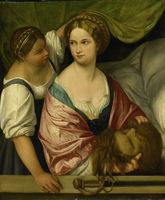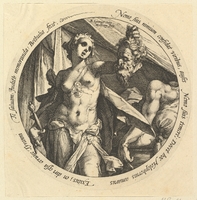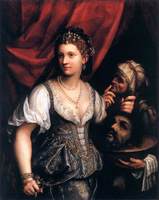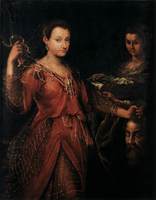Early 16th to Early 17th Century
A woman with red hair and porcelain skin is dressed elaborately in Northern Renaissance-esque garments. She is draped in rich reds, emeralds, golds and gold jewelry. In her left hand she holds the severed head of the Assyrian general Holofernes; in her right she wields the sword that killed him—almost as if she was caught in the act. The gruesome image of death is contrasted by the heroine's beauty, which is emphasized by the flat, black void of the background. Although her body is turned slightly away from us, With a knowing smirk, she confronts the viewer with her direct gaze, almost as if letting the viewer in as a witness (or accomplice) to her crime.
This panel first became known in 1911, when it was purchased by the Metropolitan Museum of Art from the estate of Robert Hoe. At the time, Holofernes' beard had been enlarged so as not to expose his severed neck. The panel shows at the lower right the insignia of Lucas Cranach the Elder in its form prior to 1537, and the technique and execution of the painting are consistent with the painting of Cranach and his workshop in the 1530s, a date supported by Judith's costume. The contemporary dress and variance in her physiognomy from piece to piece (other Judith paintings mass produced by Cranach's workshop) suggest that these were actually portraits of court women in the guise of Judith.
Born around the year 1472 in Kronach, Germany, Lucas Cranach the Elder was known in his career for his portraits of German nobility and the leading figures of the Protestant Reformation. His artistic activity had a significant influence on the evolution of the Reformation in Germany. Cranach also completed paintings in the catholic tradition, which aligns with the apocryphal text from the Book of Judith detailing Judith's defeat of Holofernes as a popular reproduction in his workshop.
Two women are stood in front of a war tent with olive green drapery, a bed seen inside. The woman on the left wears a modest, blue pinafore dress over a white underdress, hair braided simply with gold ribbon as she holds up the drapery for the woman in the center. The woman in the center appears to be exiting the tent; she is a plump woman with blonde/auburn hair braided into an intricate updo, wearing a blue dress with white underclothes and a pink cloak draped across her shoulders. She looks off to the left, holding the severed head of an older bearded man with auburn hair. In front of her is a banister where her companion's hand lays along with a sword.
Giovanni Antonio Sacchis, referred to as Pordenone after the town he was born in in the northern Italian province of Friuli, painted Judith with the Head of Holofernes in the early sixteenth century—dating around 1500-1539. His early style was based on northern Italian examples, particularly the art of Andrea Mantegna (who painted his rendition of Judith and Holofernes around 1500 as well). When he was 52, Pordenone moved to Venice where he became Titian's chief artistic rival (who painted his rendition of Judith and Holofernes in 1515).
A bare-breasted woman with an updo of ringlets holds up the severed head of Assyrian general Holofernes. Her drapery is pooled around her waist, what appears to be a harness embracing her naked torso. In her left hand is the severed head, an older bearded man withwhite hair. Strapped to her right thigh is the sword which committed the crime. In the tent in the background on the right is the body of Holofernes slumped in bed. The woman's mouth is agape, lips upturned subtley in a smile; she is neither regretful nor remorseful for her crime. The scene is presented in a circle which is surrounded by an inscription.
Hendrick Goltzius was born in 1558 Germany near the border of the Netherlands. He was an engraver, print publisher, draftsman, and painter, and was considered one of the outstanding figures in Dutch art during the late sixteenth and early seventeenth centuries. He is most widley known today for the Mannerist engravings that he and his workshop produced during the period between 1585 and 1589, of which Judith and the Head of Holofernes was among.
Two women who are stood before a red curtain ruminate in the crime they have just committed—beheading the Assyrian war general Holofernes. On the left is Judith, a woman with a head of tightly wound auburn ringlets; she is wearing an extravagant blue gown with white and gold accents, a string of pearls around her neck, gold bracelet on her right wrist, and velvet headpiece with accents of gems and pearls. She looks off to her right, avoiding the gaze of Holofernes’ severed head. The head is of a bearded man with thick black hair, mouth slightly agape, eyes open and lifeless as he looks directly at his killer. The woman holds the head in her left hand by the hair, resting it on a gold plate offered to her by her maidservant who looks at her contemplatively with a finger brought to her mouth. In her right hand she brandishes the sword which helped her enact the beheading.
Born 1578 in Milan, Italy, Fede Galizia was the daughter of a miniaturist painter who presumably trained her. Having her father's guidance from a young age, she was considered an artistic prodigy by the age of twelve. She earned an international reputation as a portrait painter and executed large-scale, public commissions. She is considered today as a pioneer in the genre of still-life painting in italy.
The biblical story of Judith made a deep impression on Galizia at an early age, and she treated the subject many times in her career. In this version, the Jewish heroine is sumptuously dressed, laden with jewelry and an elaborate headpiece. The refined manner in which the heroine's attire is executed is a reflection of the training in miniature tradition she received from her father, Nunzio.
In the foreground is a woman with dark hair; she wears a lavish red gown with gold and pearl accents. In her left hand she holds the severed head of a bearded man by the hair, and in her right she brandishes the sword which killed him; the sword is still held in mid-air, almost as if she has only just beheaded him and we caught her in the midst of her act, her gaze trained on us challengingly. The scene emerges from an otherwise completely dark, shadowed composition, another woman seemingly emerging from the shadows holding a wicker basket with a cloth in it, assumedly for the head, her dark gaze trained on us menacingly.
Lavinia Fontana was born 1552 in Bologna, Italy. The typical subject matter for women painters in the Renaissance were portraits, but Fontana was the exception for she was also commissioned to make religious and mythological paintings, and sometimes female nude paintings. She made great strides in the field of portraiture, which brought her fame within, and beyond, Italy. In fact, Fontana is sometimes regarded as the first woman artist, having worked outside a court or convent, within the same sphere as her male counterparts.
The physiognomy of Judith and her maidservant in Fontana's Judith with the Head of Holofernes has led some scholars to believe that the two figures are actually portraits. Speculation has been made about the identity of the women, and it is even suggested that the figure of Judith is a self-portrait.




